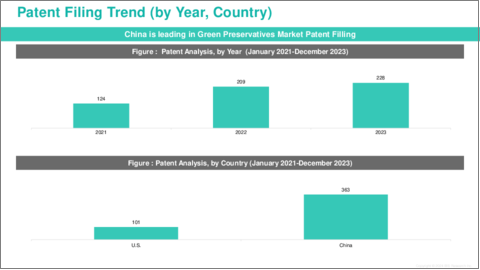|
|
市場調査レポート
商品コード
1518217
グリーン保存料市場- 世界および地域別分析:用途別、タイプ別、地域別 - 分析と予測(2024年~2034年)Green Preservatives Market - A Global and Regional Analysis: Focus on Application, Type, and Region - Analysis and Forecast, 2024-2034 |
||||||
カスタマイズ可能
|
|||||||
| グリーン保存料市場- 世界および地域別分析:用途別、タイプ別、地域別 - 分析と予測(2024年~2034年) |
|
出版日: 2024年07月23日
発行: BIS Research
ページ情報: 英文 100 Pages
納期: 1~5営業日
|
全表示
- 概要
- 目次
グリーン保存料の市場規模は、様々な市場促進要因に後押しされ、著しい成長を遂げています。
楽観的シナリオでは、市場は2024年に12億1,000万米ドルになるとみられ、CAGR 6.85%で拡大し、2034年には23億5,000万米ドルに達すると予測されています。
| 主要市場統計 | |
|---|---|
| 予測期間 | 2024年~2034年 |
| 2024年の評価 | 12億1,000万米ドル |
| 2034年の予測 | 23億5,000万米ドル |
| CAGR | 6.85% |
グリーン保存料市場は、様々な業界において持続可能で環境に優しい製品に対する消費者の需要が高まっていることを主な要因として、大きな成長を遂げています。グリーン保存料は、従来の化学ベースの保存料に代わる環境に配慮した保存料として機能し、消費者の健康と持続可能性への関心の高まりと共鳴しています。このような需要の急増は、合成保存料が人の健康や環境に与える悪影響に対する意識の高まりが後押ししています。化粧品、パーソナルケア、食品、飲食品の各業界では、製品の安全性と寿命を確保しつつ、天然で無害な成分を求める消費者の嗜好に応えるため、環境に優しい防腐剤を取り入れる必要性がますます認識されるようになっています。
さらに、グリーン保存料市場の顕著な成長のもう一つの原動力は、持続可能な保存のための技術の進歩と独創的な製造プロセスの出現です。Firmenich、Symrise、Givaudanなどの企業は、多様な分野にわたる進化する要件に対応するためにカスタマイズされた革新的なソリューションに取り組んでいます。天然成分、処方手法、顧客中心のアプローチに熟達したこれらの企業は、グリーン保存料市場の枠組みを形成する上で極めて重要です。
当レポートでは、世界のグリーン保存料市場について調査し、市場の概要とともに、用途別、タイプ別、地域別の動向、および市場に参入する企業のプロファイルなどを提供しています。
目次
エグゼクティブサマリー
第1章 市場:業界の展望
- 動向:現在および将来の影響評価
- サプライチェーンの概要
- R&Dレビュー
- 規制状況
- ステークホルダー分析
- 主要な世界的イベントの影響分析
- 市場力学の概要
第2章 グリーン保存料市場(用途別)
- 用途のセグメンテーション
- 用途の概要
- グリーン保存料市場、用途別
第3章 グリーン保存料市場(製品別)
- 製品セグメンテーション
- 製品概要
- グリーン保存料市場、タイプ別
第4章 グリーン保存料市場(地域別)
- グリーン保存料市場- 地域別
- 北米
- 欧州
- アジア太平洋
- その他の地域
第5章 企業プロファイル
- 今後の見通し
- 地理的評価
- Kerry Group plc.
- Kemin Industries, Inc.
- Corbion
- LANXESS
- Ashland
- International Flavors & Fragrances Inc.
- Dow
- dsm-firmenich
- Symrise
- Givaudan
- CLARIANT
- BASF SE
- Croda International Plc
- Evonik Industries AG
- Lonza
第6章 調査手法
Introduction to Green Preservatives Market
The green preservatives market is undergoing significant growth, propelled by various key factors and market drivers. In an optimistic scenario, the market is evaluated at a valuation of $1.21 billion in 2024 and is projected to expand at a CAGR of 6.85% to reach $2.35 billion by 2034.
| KEY MARKET STATISTICS | |
|---|---|
| Forecast Period | 2024 - 2034 |
| 2024 Evaluation | $1.21 Billion |
| 2034 Forecast | $2.35 Billion |
| CAGR | 6.85% |
The green preservatives market is experiencing significant growth, driven primarily by the heightened consumer demand for sustainable and eco-friendly products across diverse industries. Green preservatives serve as an environmentally conscious substitute for conventional chemical-based preservatives, resonating with consumers' growing focus on health and sustainability. This surge in demand is fueled by a rising awareness of the adverse impacts of synthetic preservatives on human health and the environment. Industries spanning cosmetics, personal care, food, and beverage are increasingly acknowledging the necessity of integrating green preservatives to meet consumer preferences for natural and non-toxic ingredients, while also ensuring product safety and longevity.
Additionally, another driving force behind the notable growth in the green preservatives market is the emergence of technological advancements and inventive manufacturing processes for sustainable preservation. Companies such as Firmenich, Symrise, and Givaudan, are working with innovative solutions customized to address the evolving requirements across diverse sectors. Capitalizing on their proficiency in natural components, formulation methodologies, and customer-centric approaches, these entities are pivotal in shaping the framework of the green preservatives market.
Overall, the global green preservatives market is experiencing substantial expansion, fueled by increasing consumer demand for sustainable, non-toxic, and environmentally friendly preservation solutions. This growth is further propelled by ongoing technological advancements and innovative developments in the manufacturing processes of green preservatives.
Market Segmentation:
Segmentation 1: by Application
- Food and Beverages
- Pharmaceutical
- Cosmetics
- Cleaning Industry
- Others
Segmentation 2: by Type
- Natural Preservative
- Essential Oil
- Organic Acid
- Synthetic
- Others
Segmentation 3: by Region
- North America
- Europe
- Asia-Pacific
- Rest-of-the-World
How can this Report add value to an Organization?
Product/Innovation Strategy: The global green preservatives market has been extensively segmented based on various categories, such as application, type, and region. This can help readers get a clear overview of which segments account for the largest share and which ones are well-positioned to grow in the coming years.
Competitive Strategy: A detailed competitive benchmarking of the players operating in the global green preservatives market has been done to help the reader understand how players stack against each other, presenting a clear market landscape. Additionally, comprehensive competitive strategies such as partnerships, agreements, and collaborations will aid the reader in understanding the untapped revenue pockets in the market.
Key Market Players and Competition Synopsis
The companies that are profiled have been selected based on thorough secondary research, which includes analyzing company coverage, product portfolio, market penetration, and insights gathered from primary experts.
Some of the prominent companies in this market are:
- Croda International Plc
- CLARIANT
- BASF SE
- Evonik Industries AG
- Lonza
- Dow
Key Questions Answered in this Report:
- What are the main factors driving the demand for green preservatives market?
- What are the major patents filed by the companies active in the green preservatives market?
- Who are the key players in the green preservatives market, and what are their respective market shares?
- What partnerships or collaborations are prominent among stakeholders in the green preservatives market?
- What are the strategies adopted by the key companies to gain a competitive edge in green preservatives market?
- What is the futuristic outlook for the green preservatives market in terms of growth potential?
- What is the current estimation of the green preservatives market and what growth trajectory is projected from 2024 to 2034?
- Which application, and product segment is expected to lead the market over the forecast period (2024-2034)?
- Which regions demonstrate the highest adoption rates for green preservatives market, and what factors contribute to their leadership?
Table of Contents
Executive Summary
Scope and Definition
Market/Product Definition
Key Questions Answered
Analysis and Forecast Note
1. Markets: Industry Outlook
- 1.1 Trends: Current and Future Impact Assessment
- 1.1.1 Growing Consumer Preference for Clean Label Products with Transparent Ingredient List
- 1.1.2 Increasing Regulatory Scrutiny and Consumer Demand for Certified Organic, Natural, and Eco-Friendly Products
- 1.2 Supply Chain Overview
- 1.2.1 Value Chain Analysis
- 1.2.2 Pricing Forecast
- 1.3 R&D Review
- 1.3.1 Patent Filing Trend by Country, by Company
- 1.4 Regulatory Landscape
- 1.5 Stakeholder Analysis
- 1.5.1 Use Case
- 1.5.2 End User and Buying Criteria
- 1.6 Impact Analysis for Key Global Events
- 1.7 Market Dynamics Overview
- 1.7.1 Market Drivers
- 1.7.2 Market Restraints
- 1.7.3 Market Opportunities
2. Green Preservatives Market (by Application)
- 2.1 Application Segmentation
- 2.2 Application Summary
- 2.3 Green Preservatives Market by Application
- 2.3.1 Food and Beverages
- 2.3.2 Pharmaceutical
- 2.3.3 Cosmetics
- 2.3.4 Cleaning Industry
- 2.3.5 Others
3. Green Preservatives Market (by Products)
- 3.1 Product Segmentation
- 3.2 Product Summary
- 3.3 Green Preservatives Market by Type
- 3.3.1 Natural Preservative
- 3.3.2 Essential Oil
- 3.3.3 Organic Acid
- 3.3.4 Synthetic
- 3.3.5 Others
4. Green Preservatives Market (by Region)
- 4.1 Green Preservatives Market - by Region
- 4.2 North America
- 4.2.1 Regional Overview
- 4.2.2 Driving Factors for Market Growth
- 4.2.3 Factors Challenging the Market
- 4.2.4 Application
- 4.2.5 Product
- 4.2.6 U.S.
- 4.2.6.1 Market by Application
- 4.2.6.2 Market by Product
- 4.2.7 Canada
- 4.2.7.1 Market by Application
- 4.2.7.2 Market by Product
- 4.2.8 Mexico
- 4.2.8.1 Market by Application
- 4.2.8.2 Market by Product
- 4.3 Europe
- 4.3.1 Regional Overview
- 4.3.2 Driving Factors for Market Growth
- 4.3.3 Factors Challenging the Market
- 4.3.4 Application
- 4.3.5 Product
- 4.3.6 Germany
- 4.3.6.1 Market by Application
- 4.3.6.2 Market by Product
- 4.3.7 France
- 4.3.7.1 Market by Application
- 4.3.7.2 Market by Product
- 4.3.8 U.K.
- 4.3.8.1 Market by Application
- 4.3.8.2 Market by Product
- 4.3.9 Italy
- 4.3.9.1 Market by Application
- 4.3.9.2 Market by Product
- 4.3.10 Rest-of-Europe
- 4.3.10.1 Market by Application
- 4.3.10.2 Market by Product
- 4.4 Asia-Pacific
- 4.4.1 Regional Overview
- 4.4.2 Driving Factors for Market Growth
- 4.4.3 Factors Challenging the Market
- 4.4.4 Application
- 4.4.5 Product
- 4.4.6 China
- 4.4.6.1 Market by Application
- 4.4.6.2 Market by Product
- 4.4.7 Japan
- 4.4.7.1 Market by Application
- 4.4.7.2 Market by Product
- 4.4.8 India
- 4.4.8.1 Market by Application
- 4.4.8.2 Market by Product
- 4.4.9 South Korea
- 4.4.9.1 Market by Application
- 4.4.9.2 Market by Product
- 4.4.10 Rest-of-Asia-Pacific
- 4.4.10.1 Market by Application
- 4.4.10.2 Market by Product
- 4.5 Rest-of-the-World
- 4.5.1 Regional Overview
- 4.5.2 Driving Factors for Market Growth
- 4.5.3 Factors Challenging the Market
- 4.5.4 Application
- 4.5.5 Product
- 4.5.6 South America
- 4.5.6.1 Market by Application
- 4.5.6.2 Market by Product
- 4.5.7 Middle East and Africa
- 4.5.7.1 Market by Application
- 4.5.7.2 Market by Product
5. Companies Profiled
- 5.1 Next Frontiers
- 5.2 Geographic Assessment
- 5.2.1 Kerry Group plc.
- 5.2.1.1 Overview
- 5.2.1.2 Top Products/Product Portfolio
- 5.2.1.3 Top Competitors
- 5.2.1.4 Target Customers
- 5.2.1.5 Key Personnel
- 5.2.1.6 Analyst View
- 5.2.1.7 Market Share
- 5.2.2 Kemin Industries, Inc.
- 5.2.2.1 Overview
- 5.2.2.2 Top Products/Product Portfolio
- 5.2.2.3 Top Competitors
- 5.2.2.4 Target Customers
- 5.2.2.5 Key Personnel
- 5.2.2.6 Analyst View
- 5.2.2.7 Market Share
- 5.2.3 Corbion
- 5.2.3.1 Overview
- 5.2.3.2 Top Products/Product Portfolio
- 5.2.3.3 Top Competitors
- 5.2.3.4 Target Customers
- 5.2.3.5 Key Personnel
- 5.2.3.6 Analyst View
- 5.2.3.7 Market Share
- 5.2.4 LANXESS
- 5.2.4.1 Overview
- 5.2.4.2 Top Products/Product Portfolio
- 5.2.4.3 Top Competitors
- 5.2.4.4 Target Customers
- 5.2.4.5 Key Personnel
- 5.2.4.6 Analyst View
- 5.2.4.7 Market Share
- 5.2.5 Ashland
- 5.2.5.1 Overview
- 5.2.5.2 Top Products/Product Portfolio
- 5.2.5.3 Top Competitors
- 5.2.5.4 Target Customers
- 5.2.5.5 Key Personnel
- 5.2.5.6 Analyst View
- 5.2.5.7 Market Share
- 5.2.6 International Flavors & Fragrances Inc.
- 5.2.6.1 Overview
- 5.2.6.2 Top Products/Product Portfolio
- 5.2.6.3 Top Competitors
- 5.2.6.4 Target Customers
- 5.2.6.5 Key Personnel
- 5.2.6.6 Analyst View
- 5.2.6.7 Market Share
- 5.2.7 Dow
- 5.2.7.1 Overview
- 5.2.7.2 Top Products/Product Portfolio
- 5.2.7.3 Top Competitors
- 5.2.7.4 Target Customers
- 5.2.7.5 Key Personnel
- 5.2.7.6 Analyst View
- 5.2.7.7 Market Share
- 5.2.8 dsm-firmenich
- 5.2.8.1 Overview
- 5.2.8.2 Top Products/Product Portfolio
- 5.2.8.3 Top Competitors
- 5.2.8.4 Target Customers
- 5.2.8.5 Key Personnel
- 5.2.8.6 Analyst View
- 5.2.8.7 Market Share
- 5.2.9 Symrise
- 5.2.9.1 Overview
- 5.2.9.2 Top Products/Product Portfolio
- 5.2.9.3 Top Competitors
- 5.2.9.4 Target Customers
- 5.2.9.5 Key Personnel
- 5.2.9.6 Analyst View
- 5.2.9.7 Market Share
- 5.2.10 Givaudan
- 5.2.10.1 Overview
- 5.2.10.2 Top Products/Product Portfolio
- 5.2.10.3 Top Competitors
- 5.2.10.4 Target Customers
- 5.2.10.5 Key Personnel
- 5.2.10.6 Analyst View
- 5.2.10.7 Market Share
- 5.2.11 CLARIANT
- 5.2.11.1 Overview
- 5.2.11.2 Top Products/Product Portfolio
- 5.2.11.3 Top Competitors
- 5.2.11.4 Target Customers
- 5.2.11.5 Key Personnel
- 5.2.11.6 Analyst View
- 5.2.11.7 Market Share
- 5.2.12 BASF SE
- 5.2.12.1 Overview
- 5.2.12.2 Top Products/Product Portfolio
- 5.2.12.3 Top Competitors
- 5.2.12.4 Target Customers
- 5.2.12.5 Key Personnel
- 5.2.12.6 Analyst View
- 5.2.12.7 Market Share
- 5.2.13 Croda International Plc
- 5.2.13.1 Overview
- 5.2.13.2 Top Products/Product Portfolio
- 5.2.13.3 Top Competitors
- 5.2.13.4 Target Customers
- 5.2.13.5 Key Personnel
- 5.2.13.6 Analyst View
- 5.2.13.7 Market Share
- 5.2.14 Evonik Industries AG
- 5.2.14.1 Overview
- 5.2.14.2 Top Products/Product Portfolio
- 5.2.14.3 Top Competitors
- 5.2.14.4 Target Customers
- 5.2.14.5 Key Personnel
- 5.2.14.6 Analyst View
- 5.2.14.7 Market Share
- 5.2.15 Lonza
- 5.2.15.1 Overview
- 5.2.15.2 Top Products/Product Portfolio
- 5.2.15.3 Top Competitors
- 5.2.15.4 Target Customers
- 5.2.15.5 Key Personnel
- 5.2.15.6 Analyst View
- 5.2.15.7 Market Share
- 5.2.1 Kerry Group plc.





